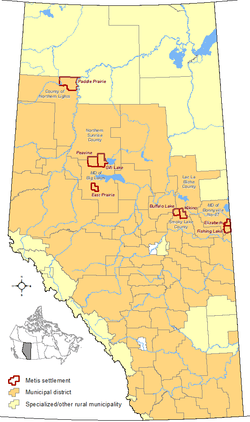Métis in Alberta
| Aboriginal peoples in Canada |
|---|
|
History
|
|
Politics
|
|
Culture
|
|
Demographics
|
|
Religions |
|
Index
|
|
Wikiprojects Portal
WikiProject
First Nations Inuit Métis |
Métis in Alberta are Métis people, descendants of mixed First Nations/native Indian and White/European families, who live in the Canadian province of Alberta. The Métis are considered an aboriginal group under Canada's constitution but are in some respects separate from the First Nations (though they live in the same regions and have cultural similarities), and have different legal rights. In Alberta, unlike in the rest of Canada, Métis people have had certain lands reserved for them, known as Métis Settlements. These Settlements are governed by a distinct and unquie Metis Government know as the Metis Settlements General Council (MSGC), formally know as the Federation of Metis Settlements. MSGC is the second largest land owner in the Province of Alberta.

History
Métis history in Alberta begins with the Fur Trade in North America. The Métis were created as a people by the interactions of White fur trading agents with First Nations communities. Métis populations grew up around fur trading posts of the North-West and Hudson's Bay companies.[1] For example, Fort Edmonton spawned a large Métis population that was involved in an annual buffalo hunt for many years.[2] These Métis helped to establish the nearby settlements of Lac Ste Anne (1844),[3] St. Albert (1861),[4] Lac la Biche (1853), and St. Paul de Métis.[5] The Hudson's Bay Company's claim in the west (called Rupert's Land) was sold to Canada in 1869 and its legal monopoly on the fur trade (not enforced since the trail of Métis trapper Guillaume Sayer in 1849) was officially ended in 1870. On the one hand this was an economic boon to the Métis as it opened the fur and buffalo meat trades to private Métis traders; however, it also exposed them to a flood of White European and Canadian people into their traditional homelands. Métis living further east in what later became Manitoba and Saskatchewan took up arms against the Canadian government in the two failed Riel Rebellions (or "Riel Resistance", 1870 and 1885) in attempt to assert their rights in the face of the newcomers. The end of these rebellions combined with the collapse of the fur and buffalo meat industries forced many Albertan Métis off their lands and reduced them to poverty. On the whole, the Métis culture and community survived, with farming replacing bison hunting and fur trading as the main economic activity in the Parkland Belt, though trapping and hunting have remained very important in the Rocky Mountain and Boreal Forest regions. More urban Metis who live in close proximity to other cultural groups may have intermarried and assimilated into mainstream Albertan society to the point that their descendants no longer think of themselves as Métis. However, in much of Northern Alberta, the Métis in more remote rural and isolated communities have remained culturally distinct. Many of the Metis Settlements have retained their cultural heritage.
As a response to Métis dispossession and impoverishment, Métis political organization, dormant since the Riel Rebellions, was revived in the late 1920s, by a number of competing organizations such as the Half-Breed Association, the Métis Association, and the Half-breed Association of Northern Alberta. In 1932 a lasting organization was founded as L’Association des Métis d’Alberta et les Territories du Nord-Ouest by Malcolm Norris, Jim Brady, Peter Tomkins, Joseph Dion and Felix Calliou (the Métis "famous five"). The Famous Five would go on to pressure the Government of Alberta on behalf of the Metis populations for a protected homeland, the Metis Settlements. In response to their lobbying, the Alberta legislature asked for an investigation, which became the Ewing Commission (a royal commission) of 1934–1936. Its report called for a Métis land base provided by the provincial government.
The result of the report was the creation of twelve Métis settlements in 1938 by way of the Métis Population Betterment Act. In the late 1950s four of these settlements (Touchwood, Marlboro, Cold Lake, and Wolf Lake) were closed, requiring residents to relocate to one of the remaining eight settlements, all north of Edmonton.
The Alberta Federation of Metis Settlements Associations was formed in 1975 as the umbrella organization for the eight settlement councils.
In 1990, through decades of negotiations and meetings, the Federation of Metis Settlements and the Crown in the Province of Alberta reached an agreement, the Alberta-Metis Settlements Accord,[6] that involved the payment of $310 million to the Métis by Alberta and the passage of four bills. The legislation consisted of Bill 33, the Metis Settlements Accord Implementation Act; Bill 34, the Metis Settlements Land Protection Act; Bill 35, the Metis Settlements Act and Bill 36, the Constitution of Alberta Amendment Act 1990. By this legislation, title to a total of 1,250,000 acres (510,000 ha) of land was transferred to a new body, the Metis Settlements General Council.[7][8]
As of the 2006 Canadian census, Big Lakes County had the most Métis people per capita of any Canadian census subdivision with a population of 5,000 or more, due to the census' inclusion of the population of three Métis settlement municipalities within Big Lakes' totals.
Recently, many other Métis people have moved to larger urban centres, becoming urban aboriginals. In 2006, a total of 27,740 persons living in the Edmonton census metropolitan area identified as Métis, accounting for just over half (53%) of the region's Aboriginal population.[9] Between 2001 and 2006 the Métis population of the Edmonton region grew by 32%.[9] Despite their recent legal victories, in 2006 Métis people in Alberta still faced higher rates of unemployment and disease, lower average incomes than their non-aboriginal neighbours.[9]
The Mountain Métis
The Mountain Métis are a distinct Métis group who are descended from Métis who lived in the Athabasca River valley near Jasper House in the Rocky Mountains of Alberta. In 1909 and 1910 a small group of families were evicted from Jasper National Park by the federal government to enable the creation of the park. They were compensated only for their improvements made to the land and not the land itself. Their descendants have fought since that time for compensation and recognition of their rights as an Aboriginal group. Their lobbying (along with non-Métis trappers and guides) was partly responsible the creation of the Willmore Wilderness Park in the 1950s, which they hoped would protect this hunting and trapping ground from oil and gas exploration.[10] They have since come into conflict with some environmentalists and government officials who would prefer to exclude hunting and trapping from all parks in Alberta.[11]
The Mountain Métis are represented by Grande Cache Metis Local 1994.
Métis Nation of Alberta
Métis people in Alberta are also represented by the Métis Nation of Alberta.
The Métis Nation of Alberta (MNA) has a long history. Since its inception in 1928, it has existed to advocate on behalf of and meet the needs and aspirations of Métis people in Alberta.
The mandate of the MNA is to:
- be a representative voice on behalf of Métis people in Alberta;
- provide Métis people an opportunity to participate in government’s policy and decision making process; and, most importantly;
- promote and facilitate the advancement of Métis people through the pursuit of self-reliance, self-determination and self-management.
Overall, the MNA has evolved from an organization:
- with a small membership to an organization whose membership exceeds 35,000 people spread across the Province;
- focused on community consultation and representation to an organization that is both a representative body and a program and service provider;
- responsible for implementing specific projects to an organization responsible for providing ongoing programs and services;
- that simply reacted to government policy changes to an organization that is called upon to actively participate in the policy-making process.
Over the past 15 years, a new set of expectations has been established for the MNA through the:
- Alberta/MNA Framework Agreement process;
- Federal/Provincial/MNA Tripartite Process Agreement process; and
- Government of Alberta’s Aboriginal Policy Framework.
This period has also seen a steady rise in the number of Métis people in the Province who have registered as members of the MNA. Membership in the MNA grew by almost 300% in the last decade. Clearly, more and more Métis people in Alberta recognize the benefits of MNA memberships and the importance of the MNA as an organization.
As well, the MNA has made a transition from solely a representative body to an organization responsible and accountable for the ongoing delivery of a variety of programs and services. The MNA has continued to make significant strides as an organization and has been successful in developing and implementing a number of projects and initiatives (including Apeetogosan Development Inc., Métis Urban Housing Corporation of Alberta and the Aboriginal Human Resource Development Agreement – Labour Market Unit.)
The MNA has accepted new responsibilities and expectations and is moving towards becoming a more “results-based” organization. It has addressed issues relating to internal governance and has, in turn, developed the administrative capacity to meet the expectations that are placed upon it.
The MNA has proven itself very capable of playing a role in the policy development process. Its elected officials and staff sit on a wide range of committees responsible for an even wider array of issues.
The MNA, like any organization, has gone through a distinct evolution in its history. While it has had to deal with any number of contentious issues over the years, the MNA’s development has been built upon a strong record of successes, often achieved with minimal financial resources.
The Rupertsland Institute of Alberta is an affiliate to the Metis Nation of Alberta. Their mission is to enhance the individual self-sufficiency and the collective well-being of Metis people through quality education, training and research. www.rupertsland.org
List of settlements

The Metis Settlements General Council "is the political and administrative body for the collective interests of the eight Metis Settlements... the General Council has 44 members consisting of 40 elected members from the Settlements, and 4 elected Executive members."[12]
See also
- List of communities in Alberta
- List of designated places in Alberta
- List of Indian reserves in Alberta
- List of municipalities in Alberta
Notes
References
- ↑ http://www.albertasource.ca/metis/eng/beginnings/introduction_origins.htm
- ↑ http://www.albertasource.ca/metis/eng/beginnings/metis_nw_settlements.htm
- ↑ "Oblates in the West "The Alberta Story" (Lac Ste. Anne / St. Albert)". Retrieved January 19, 2014.
- ↑ "St. Albert Settlement". Alberta Culture. Government of Alberta. 1995–2012. Retrieved January 16, 2014.
- ↑ http://www.albertasource.ca/metis/eng/beginnings/metis_nw_agriculture.htm
- ↑ http://www.aboriginal.alberta.ca/documents/AlbertaMetisSettlementsAccord.pdf
- ↑ http://www.ammsa.com/publications/windspeaker/metis-legislation-gets-royal-assent#sthash.49sZwHvQ.dpuf
- ↑ http://www.aboriginal.alberta.ca/documents/BriefHistoryMetis.pdf
- 1 2 3 http://www.statcan.gc.ca/pub/89-638-x/2010003/article/11077-eng.htm
- ↑ http://www.mountainmetis.com/
- ↑ http://www.willmorewilderness.com/newsletters/8.Nov%20Newsletter_08.pdf
- ↑ http://www.msgc.ca/Governance/default.ksi
External links
- Métis Nation of Alberta
- Métis Settlements Act
- Student, aboriginal studies oriented dedicated to the Alberta Métis Settlements - history, documents, legislation, photographs and other research text